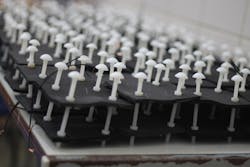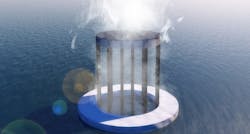As the events of 2020 have demonstrated, access to safe water is an essential part of public health. With 1.42 billion people in the world living in areas of high to extremely high water vulnerability according to UNICEF, innovative solutions to water treatment are on the rise. Across the globe, forward-thinking researchers have identified innovative methods to improve water quality, all made from inexpensive, easy-to-source materials. Below, we highlight some of these methods, many of which are environmentally sustainable.
Getting Dirty for Clean Water
Engineers at the University of Bath (England) have shown that it’s possible to capture and use energy created by the natural reactions occurring in microorganisms within soil.
According to the researchers, SFMCs generate energy from the metabolic activity of specific microorganisms (electrigens) naturally present in soil, which can transfer electrons outside of their cells.
In a pilot project, two carbon-based electrodes were positioned at a fixed distance (4 cm) apart and connected to an external circuit. One electrode, the anode, was buried inside the soil, while the other, the cathode, was exposed to air on the soil surface.
“Electrigens populate the surface of the anode and as they ‘consume’ the organic compounds present in soil, they generate electrons. These electrons are transferred to the anode and travel to the cathode via the external circuit, generating electricity,” the researchers said.
“By building a stack of several SMFCs, and by connecting this to a battery, it is possible to harvest and store this energy and use it to power an electrochemical reactor for water treatment.”
In 2019, the technology was installed at the EEF Professora Mizinha of Icapuí primary school in Brazil and has been successfully used to purify up to three liters of water a day. While further research is needed to scale-up its capacity, the researchers note that a single SMFC unit costs just a few dollars, which could be further reduced with mass production and with the use of local resources for the electrode fabrication.
Harnessing the Power of the Sun
An Australian team has refined a method of extracting fresh water from seawater, contaminated and brackish water via solar evaporation that results in enough daily water for a family of four from one square meter of source water.
“We have overcome these inefficiencies, and our technology can now deliver enough fresh water to support many practical needs at a fraction of the cost of existing technologies like reverse osmosis,” Associate Professor Haolan Xu said.
The three-dimensional evaporation system is built with a fin-shaped, photothermal structure that sits on the surface of a water source. The device stays at a lower temperature than its surrounding water and air, allowing additional energy from the warmer external environment to flow into the evaporator.
The process works by focusing the sun’s heat to evaporate the top layer of the water. The technology has been shown to successfully deliver between 20 and 30 liters of fresh water per square meter per day.
“This technology really has the potential to provide a long-term clean water solution to people and communities who can’t afford other options, and these are the places such solutions are most needed,” Xu said.
With various potential applications for adapting the technology, the researchers say they are only at the beginning of discovering applications in the clean water space.
Lessons From the Battlefield
With funding from the U.S. Army Research Office, scientists at the University of Rochester (N.Y.) have developed a new water purification method, designed for use by soldiers in the field and citizens around the world.
The researchers developed a laser processing technology that turns regular aluminum pitch black, making it highly light absorptive, while increasing its water wicking capabilities to improve solar water purification.
According to the Army Research Office, “when the aluminum panel is dipped in water at an angle facing the sun, it draws a thin film of water upward over the metal’s surface. At the same time, the blackened surface retains nearly 100 percent of the energy it absorbs from the sun to quickly heat the water. Finally, the wicking surface structures change the inter-molecular bonds of the water, increasing the efficiency of the evaporation process even further.”
The new aluminum panel uses solar energy to pulls a thin layer of water out of a reservoir and directly onto the solar absorber surface for heating and evaporation. Lab testing shows that the method reduces contaminant levels, producing safe drinking water free from heavy metals.
“Moreover, because we use an open-grooved surface, it is very easy to clean by simply spraying it,” Chunlei Guo, professor of optics at University of Rochester, said. “The biggest advantage is that the angle of the panels can be continuously adjusted to directly face the sun as it rises and then moves across the sky before setting — maximizing energy absorption.”
The team said the technology could be useful in drought-stricken areas and for water desalination projects. They are looking for other applications.
Taking Notes from Trees
A wilderness survival method has turned high-tech, thanks to a team from the Massachusetts Institute of technology (MIT).
The researchers sliced and treated small cross-sections of white pine bark from branches around the MIT campus and showed that the resulting filters maintained a permeance comparable to commercial water filters. The process works because of the internal structure of the trees, which contain sapwood lined with “straw-like conduits known as xylem, which draw water up through a tree’s trunk and branches.” These conduits, connected via thin membranes within the plant, act as natural sieves, filtering out bubbles from water and sap.
MIT’s new fabricated xylem filters have successfully filtered out pathogens such as E. coli and rotavirus in lab tests.
A system fitted with replaceable xylem filters was tested in India using native trees as source material. The system effectively purified water at a rate of one liter per hour, but as the branches dried, membranes began to stick to the walls, reducing the filter’s ability to allow water to flow through. The filters also appeared to “self-block” over time, building up woody matter that clogged the conduits.
To solve these problems, the researchers found that soaking small cross-sections of sapwood in hot water for an hour, then dipping them in ethanol and letting them dry returned the filters to working condition.
Results from the team’s work in India have led to the development of a prototype, fitted with a receptacle at the top that users can fill with water. The water flows down a 1-meter-long tube, through a xylem filter, and out through a valve-controlled spout. The xylem filter can be swapped out either daily or weekly, depending on use.
To make xylem filters available at large scale, the MIT team has launched an open-source website, www.xylemwaterfilter.org, with guidelines for designing and fabricating these filters from various tree types.
Conclusion
Estimates show that more than half the global population, will experience “high water stress” by 2025. With new filtration methods and low-energy purification technology made from easily sourced materials, this number could decrease dramatically. Thanks to forward-thinking research, a solution to the world’s water crisis could finally be within reach. WW
About the Author: Alanna Maya is Editor of WaterWorld. Email her at [email protected].
About the Author

Alanna Maya
Chief Editor
Alanna Maya is a San Diego State University graduate with more than 15 years of experience writing and editing for national publications. She was Chief Editor for WaterWorld magazine, overseeing editorial, web and video content for the flagship publication of Endeavor's Water Group. In addition, she was responsible for Stormwater magazine and the StormCon conference.




